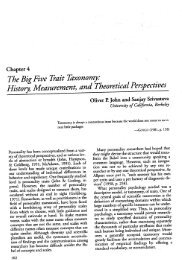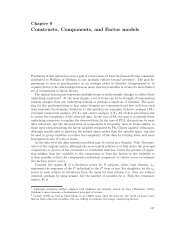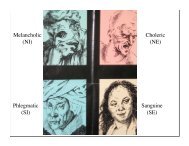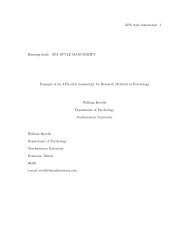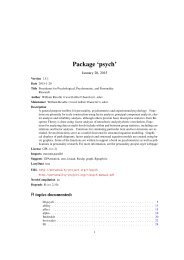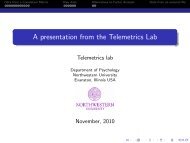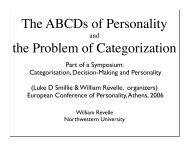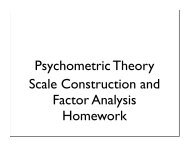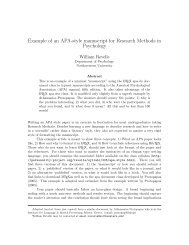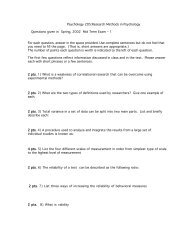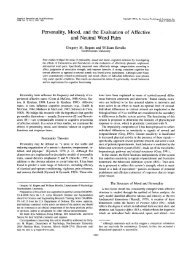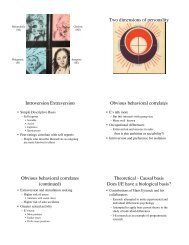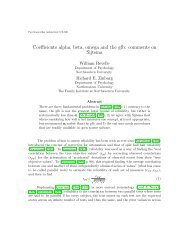Personality is more than you think: Abilities, Temperament, Interests ...
Personality is more than you think: Abilities, Temperament, Interests ...
Personality is more than you think: Abilities, Temperament, Interests ...
You also want an ePaper? Increase the reach of your titles
YUMPU automatically turns print PDFs into web optimized ePapers that Google loves.
Descriptive models Biologically inspired causal theories A new organization<br />
<strong>Personality</strong> <strong>is</strong> <strong>more</strong> <strong>than</strong> <strong>you</strong> <strong>think</strong>: <strong>Abilities</strong>,<br />
<strong>Temperament</strong>, <strong>Interests</strong>, and Character<br />
William Revelle<br />
David Condon and Joshua Wilt<br />
<strong>Personality</strong>, Motivation and Cognition lab<br />
Department of Psychology<br />
Northwestern University<br />
Evanston, Illino<strong>is</strong> USA<br />
as part of a conference:<br />
Beyond Correlation in the Study of <strong>Personality</strong>:<br />
Associations, Investments and Interventions<br />
December 10, 2010
Descriptive models Biologically inspired causal theories A new organization<br />
Outline<br />
1 Descriptive models<br />
A selective h<strong>is</strong>tory of 20th century personality research<br />
Predictive power of personality traits<br />
Behavior genetics<br />
2 Biologically inspired causal theories<br />
3 A new organization<br />
Integrating temperament, ability and interests<br />
Prior demonstrations of the power of temperament, abilities<br />
and interest<br />
A need for integrative studies<br />
SAPA: A new methodology<br />
A tentative model<br />
<strong>Temperament</strong>, Ability and <strong>Interests</strong>
Descriptive models Biologically inspired causal theories A new organization<br />
A selective h<strong>is</strong>tory of 20th century personality research<br />
A selective h<strong>is</strong>tory of personality theory<br />
D<strong>is</strong>tingu<strong>is</strong>hing between descriptive and causal models<br />
American descriptive taxonomic models<br />
European biologically based modesl<br />
American taxonomic models<br />
Taxonomic confusion and challenge<br />
Consensus model of the “Big 5”<br />
European models of biological causes of temperament<br />
Giant 3 models of Hans Eysenck<br />
2 reinforcement models developed by Jeffrey Gray
Descriptive models Biologically inspired causal theories A new organization<br />
A selective h<strong>is</strong>tory of 20th century personality research<br />
The conventional US taxonomic model – the Big 5 – 1950—1980<br />
1950 – 1980<br />
Taxonomic analyses of items<br />
and scales from most personality<br />
tests showed confusing structures.<br />
However analyses of structure<br />
of lexical items yielded a similar<br />
structure of peer and self report.<br />
Traits<br />
Neurotic<strong>is</strong>m<br />
Agreeableness<br />
Conscientiousness<br />
Th<strong>is</strong> lead to the consensual<br />
structure known as the the “Big 5”<br />
Extraversion<br />
Openness
Descriptive models Biologically inspired causal theories A new organization<br />
A selective h<strong>is</strong>tory of 20th century personality research<br />
The Big 5, dimensions of people or delusions of observers?<br />
1968-1980<br />
The “dark ages” of personality<br />
Traits are shared delusions.<br />
Traits<br />
Neurotic<strong>is</strong>m<br />
Agreeableness<br />
Traits are in the<br />
eye of the beholder.<br />
Conscientiousness<br />
Traits do not predict anything<br />
“<strong>Personality</strong> coefficient” = .3.<br />
Extraversion<br />
Openness
Descriptive models Biologically inspired causal theories A new organization<br />
A selective h<strong>is</strong>tory of 20th century personality research<br />
The Big 5, dimensions of people or delusions of observers?<br />
Traits<br />
Neurotic<strong>is</strong>m<br />
Are traits shared delusions?<br />
Agreeableness<br />
Are traits in the<br />
eye of the beholder?<br />
Conscientiousness<br />
Do traits add anything<br />
to understanding behavior?<br />
Extraversion<br />
Openness
Descriptive models Biologically inspired causal theories A new organization<br />
Predictive power of personality traits<br />
The conventional US model: with some behavioral correlates<br />
Traits<br />
Behaviors<br />
Neurotic<strong>is</strong>m<br />
Traits are stable and have<br />
predictive power<br />
over the lifespan<br />
Agreeableness<br />
Conscientiousness<br />
Getting<br />
along<br />
Roberts and DelVecchio (2000)<br />
Caspi, Roberts and Shiner (2005)<br />
Extraversion<br />
Openness<br />
Getting<br />
ahead
Descriptive models Biologically inspired causal theories A new organization<br />
Predictive power of personality traits<br />
The conventional model: with some predictive powers<br />
Traits are stable and have<br />
predictive power<br />
over lifespan<br />
Mortality<br />
Divorce<br />
Employment<br />
Roberts, Kuncel, Shiner,<br />
Caspi and Goldberg, (2007)<br />
Traits<br />
✛✘<br />
N<br />
❍<br />
✚✙ ❍❍❍❍❍❍❥✲<br />
✛✘<br />
A<br />
✚✙<br />
✛✘<br />
C<br />
❍<br />
✟ ✟✟✟✟✟✟✯<br />
✚✙ ❍❍❍❍❍❍❥✲<br />
✛✘<br />
E<br />
✚✙<br />
✛✘<br />
O ✟ ✟✟✟✟✟✟✯<br />
✚✙<br />
Behaviors<br />
Getting<br />
along<br />
Getting<br />
ahead
Descriptive models Biologically inspired causal theories A new organization<br />
Behavior genetics<br />
The beginning of causal <strong>think</strong>ing: all traits have heritabilities ≈ .5 ± .2<br />
Genes<br />
Behavior genetic studies<br />
r MZa = r MZt ≈ 2r DZt<br />
Big 5 traits have h 2 ≈ .5<br />
No evidence for shared<br />
(family) environment.<br />
Traits<br />
✛✘<br />
N<br />
❍<br />
✚✙ ❍❍❍❍❍❍❥✲<br />
✛✘<br />
A<br />
✚✙<br />
✛✘<br />
C<br />
❍<br />
✟ ✟✟✟✟✟✟✯<br />
✚✙ ❍❍❍❍❍❍❥✲<br />
✛✘<br />
E<br />
✚✙<br />
✛✘<br />
O ✟ ✟✟✟✟✟✟✯<br />
✚✙<br />
Behaviors<br />
Getting<br />
along<br />
Getting<br />
ahead
Descriptive models Biologically inspired causal theories A new organization<br />
Behavior genetics<br />
The beginning of causal <strong>think</strong>ing: all traits have heritabilities ≈ .5 ± .2<br />
Genes<br />
Behavior genetic studies<br />
r MZa = r MZt ≈ 2r DZt<br />
Big 5 traits have h 2 ≈ .5<br />
But so do divorce,<br />
religiousness and watching TV<br />
Traits<br />
✛✘<br />
N<br />
❍<br />
✚✙ ❍❍❍❍❍❍❥✲<br />
✛✘<br />
A<br />
✚✙<br />
✛✘<br />
C<br />
❍<br />
✟ ✟✟✟✟✟✟✯<br />
✚✙ ❍❍❍❍❍❍❥✲<br />
✛✘<br />
E<br />
✚✙<br />
✛✘<br />
O ✟ ✟✟✟✟✟✟✯<br />
✚✙<br />
Behaviors<br />
Getting<br />
along<br />
Getting<br />
ahead
Descriptive models Biologically inspired causal theories A new organization<br />
Behavior genetics<br />
The beginning of causal <strong>think</strong>ing: all traits have heritabilities ≈ .5 ± .2<br />
Genes<br />
Behavior genetic studies<br />
r MZa = r MZt ≈ 2r DZt<br />
Big 5 traits have h 2 ≈ .5<br />
No evidence for shared<br />
(family) environment.<br />
Within group heritabilities are<br />
uninformative wrt<br />
between group differences<br />
(Consider height: Johnson, 2010)<br />
Traits<br />
✛✘<br />
N<br />
❍<br />
✚✙ ❍❍❍❍❍❍❥✲<br />
✛✘<br />
A<br />
✚✙<br />
✛✘<br />
C<br />
❍<br />
✟ ✟✟✟✟✟✟✯<br />
✚✙ ❍❍❍❍❍❍❥✲<br />
✛✘<br />
E<br />
✚✙<br />
✛✘<br />
O ✟ ✟✟✟✟✟✟✯<br />
✚✙<br />
Behaviors<br />
Getting<br />
along<br />
Getting<br />
ahead
Descriptive models Biologically inspired causal theories A new organization<br />
Biologically inspired causal theories<br />
During the 1950s - 1990s, while Americans focused on<br />
descriptive taxonomies and debated whether personality made<br />
a difference, trait theory was alive and well and living in<br />
Europe.<br />
The Europeans emphasized biological models of the “Giant 3”:<br />
Extraversion, Neurotic<strong>is</strong>m, and “Psychotic<strong>is</strong>m” (also called<br />
“tough mindedness”).<br />
They also included the study of intelligence as part of the<br />
study of personality and individual differences.
Descriptive models Biologically inspired causal theories A new organization<br />
Theories of learning and reinforcement–primarily European<br />
Genes/Proteins Systems Traits Behaviors<br />
✛✘<br />
Pun<strong>is</strong>hment<br />
N<br />
Sensitivity<br />
❍<br />
✚✙ ❍❍❍❍❍❍❥✲<br />
“Tough minded”<br />
Testosterone?<br />
Reward<br />
Sensitivity<br />
Intelligence<br />
✛✘<br />
A<br />
✟ ✟✯ ✚✙<br />
❍ ❍❥ ✛✘<br />
C<br />
❍<br />
✟ ✟✟✟✟✟✟✯<br />
✚✙ ❍❍❍❍❍❍❥✲<br />
✛✘<br />
E<br />
✚✙<br />
✛✘<br />
g ✟ ✟✟✟✟✟✟✯<br />
✚✙<br />
Getting<br />
along<br />
Getting<br />
ahead
Descriptive models Biologically inspired causal theories A new organization<br />
Theories of learning and reinforcement: The “Gray model”<br />
Genes/Proteins Systems Traits Behaviors<br />
✛✘<br />
Behavioral Inhibition<br />
(BIS)<br />
Testosterone?<br />
Behavioral Approach<br />
(BAS)<br />
N<br />
❍<br />
✚✙ ❍❍❍❍❍❍❥✲<br />
✛✘<br />
A<br />
✟ ✟✯ ✚✙<br />
❍ ❍❥ ✛✘<br />
C<br />
❍<br />
✟ ✟✟✟✟✟✟✯<br />
✚✙ ❍❍❍❍❍❍❥✲<br />
✛✘<br />
E<br />
✚✙<br />
✛✘<br />
g ✟ ✟✟✟✟✟✟✯<br />
✚✙<br />
Getting<br />
along<br />
Getting<br />
ahead
Descriptive models Biologically inspired causal theories A new organization<br />
Reinforcement Sensitivity Theory (RST) the rev<strong>is</strong>ed “Gray model”<br />
Genes<br />
Proteins<br />
Systems Traits Behaviors<br />
✛✘<br />
Flight/Freeze/Fight<br />
(FFFS)<br />
Behavioral Inhibition ✛✘ A<br />
(BIS)<br />
T ✟ ✟✯ ✚✙<br />
❍<br />
✚✙ ❍❥ ✛✘<br />
C<br />
❍<br />
✟ ✟✟✟✟✟✟✯<br />
✚✙ ❍❍❍❍❍❍❥✲<br />
Behavioral Approach<br />
(BAS)<br />
N<br />
❍<br />
✚✙ ❍❍❍❍❍❍❥✲<br />
✛✘<br />
✛✘<br />
E<br />
✚✙<br />
✛✘<br />
g ✟ ✟✟✟✟✟✟✯<br />
✚✙<br />
Getting<br />
along<br />
Getting<br />
ahead
Descriptive models Biologically inspired causal theories A new organization<br />
Reinforcement Sensitivity Theory (RST) the rev<strong>is</strong>ed “Gray model”<br />
Genes<br />
Proteins<br />
Systems Traits Behaviors<br />
✛✘ ✛✘<br />
FFFS<br />
✲ N<br />
✚✙<br />
✻<br />
❍<br />
✚✙ ❍❍❍❍❍❍❥✲<br />
❇<br />
❇<br />
✛✘<br />
❇<br />
Getting<br />
A<br />
❇❇◆ ✗✔<br />
BIS x ❤ T ✟ ✟✯<br />
along<br />
✚✙<br />
❍<br />
✂ ✂✂✍<br />
✖✕ ❍❥ ✛✘<br />
C<br />
❍<br />
✟ ✟✟✟✟✟✟✯<br />
✂<br />
✚✙ ❍❍❍❍❍❍❥✲<br />
✛✘ ✂<br />
BAS ❄<br />
✚✙<br />
✛✘<br />
✲ E<br />
✚✙<br />
✛✘<br />
g ✟ ✟✟✟✟✟✟✯<br />
✚✙<br />
Getting<br />
ahead
Descriptive models Biologically inspired causal theories A new organization<br />
Integrating temperament, ability and interests<br />
Integrating temperament, ability and interests<br />
<strong>Personality</strong> theor<strong>is</strong>ts from the 1920s to late 1940s included<br />
ability and interests in personality formulations (e.g., Kelly &<br />
F<strong>is</strong>ke, 1950).<br />
Perhaps in a desire to be theoretical rather <strong>than</strong> applied, and<br />
not to d<strong>is</strong>cuss the socially dangerous idea of intelligence,<br />
American personality psycholog<strong>is</strong>ts from the 1950s until the<br />
present have avoided or ignored the study of ability and<br />
interests.<br />
Exceptions include Lubinski & Benbow (2000); Lubinski,<br />
Webb, Morelock & Benbow (2001); Lubinski & Benbow (2006)<br />
Ackerman (1997), Ackerman & Heggestad (1997)<br />
Kuncel, Campbell & Ones (1998); Kuncel, Hezlett & Ones<br />
(2001); Kuncel, Crede & Thomas (2005)<br />
Ability was left to school psycholog<strong>is</strong>ts, interests to counseling<br />
psychology. However, both were included in I/O psychology.<br />
It <strong>is</strong> time to rectify that oversight. What follows <strong>is</strong> a tentative<br />
proposal.
Descriptive models Biologically inspired causal theories A new organization<br />
Ability by Stanine<br />
Prior demonstrations of the power of temperament, abilities and interest<br />
The power of ability: Army Airforce Selection<br />
Army airforce selection study: predicting passing training based<br />
upon stanine of screening battery. Multiple R ≈ .42<br />
Percentage passing<br />
0 20 40 60 80 100<br />
S1 S2 S3 S4 S5 S6 S7 S8 S9
Descriptive models Biologically inspired causal theories A new organization<br />
Prior demonstrations of the power of temperament, abilities and interest<br />
<strong>Temperament</strong>, ability, interests: Kelly and F<strong>is</strong>ke (1950)<br />
A classic study of graduate school success showed how<br />
temperament, ability, and interests all predicted performance<br />
equally well (Kelly & F<strong>is</strong>ke, 1950).<br />
Graduate students enrolled in 40 different clinical psychology<br />
programs in 1946 were evaluated by ≈ 75 psycholog<strong>is</strong>ts at UM<br />
Criteria included ratings of clinical diagnos<strong>is</strong>, skill at individual<br />
therapy, research skills, preference for hiring<br />
Predictive measures that worked included<br />
Ability: Millers analogy test<br />
<strong>Temperament</strong>: Measures of neurotic<strong>is</strong>m<br />
<strong>Interests</strong>: Measures of psychological mindedness in interests<br />
“The most efficient clinical predictions, in terms of both<br />
validity and economy of data, are those based only on the<br />
materials contained in the credentials file and in the objective<br />
test profiles. The addition of autobiographical and projective<br />
test data appears to have contributed little or nothing to the
Descriptive models Biologically inspired causal theories A new organization<br />
A need for integrative studies<br />
A need for integrative studies<br />
Prior work has shown that there <strong>is</strong> a need to integrate<br />
<strong>Temperament</strong>, <strong>Abilities</strong> and <strong>Interests</strong>.<br />
But how to do it?<br />
To integrate the areas requires large sample sizes, ease of data<br />
collection, and a diverse subject population.<br />
Some do th<strong>is</strong> through meta analys<strong>is</strong>, some use broad based<br />
national samples.<br />
Is it possible for single labs to do integrative studies?
Descriptive models Biologically inspired causal theories A new organization<br />
A need for integrative studies<br />
How to do integrative studies?<br />
Problem of small samples sizes based upon college<br />
undergraduates. Typical subject pools are neither large<br />
enough nor diverse enough.<br />
Expensive to get access to large and diverse populations<br />
Exceptions include national and international survey samples<br />
using preselected items:<br />
National Longitudinal Study of Youth (NLSY)<br />
Program for International Student Assessment (PISA)<br />
German Socio-Economic Panel<br />
Is it possible to do large based sampling with tailored items?<br />
Yes, use the web.
Descriptive models Biologically inspired causal theories A new organization<br />
SAPA: A new methodology<br />
Synthetic Aperture <strong>Personality</strong> Assessment (SAPA)<br />
Using the web to collect data on temperament, ability and<br />
interests<br />
Synthetically form large covariance matrices from smaller<br />
subsets of items<br />
Each subject given ≈ 50 personality, 10 interest, and 14 ability<br />
items sampled from the larger pool.<br />
Total pool of items > 500<br />
≈ 400 personality items primarily from International<br />
<strong>Personality</strong> Item Pool Goldberg (1999)<br />
92 interest items for Oregon Vocational Interest Scales<br />
(Pozzebon, V<strong>is</strong>ser, Ashton, Lee & Goldberg, 2010)<br />
56 ability items (home brewed at NU)<br />
Demographic items include age, sex, education, race, country,<br />
college major, occupation (if appropriate)<br />
Resulting sample sizes > 50, 000 − 100, 000<br />
College major, occupational status and interest items added in<br />
9/10<br />
Data to be summarized include ≈ 12, 000 participants
Descriptive models Biologically inspired causal theories A new organization<br />
A tentative model<br />
<strong>Temperament</strong>, abilities, interest, character<br />
Genes <strong>Temperament</strong> Character Surface <strong>Interests</strong>/<br />
✛✘✗✔<br />
Traits skills<br />
FFFS ✲ Av<br />
✲ N <br />
✚✙<br />
✻<br />
<br />
✖✕<br />
Proteins❆<br />
✗✔<br />
✲<br />
❆<br />
❆❆❯<br />
✗✔A<br />
✲ A<br />
BIS x ❤ T ✒ ✖✕<br />
✏✶<br />
✁ ✁✁✕ ✖✕ ❅<br />
✗✔<br />
❅❘<br />
C ✲ C ✏✏✏✏✏✏✏ <br />
Systems<br />
✖✕<br />
✛✘ ✁ ✗✔<br />
✲<br />
BAS ❄✲<br />
App<br />
✲ E<br />
✚✙✖✕<br />
❳❳ ❳❳ ✏✶<br />
❳ ❳❳ ✑✸<br />
❳❳3<br />
O ✏✏✏✏✏✏✏ ✗✔<br />
g ✘ ✘ ✘ ✘✘ ✘ ✘ ✘✘✿<br />
✑✑✑✑✑✑<br />
✲ g ✑<br />
✖✕<br />
Behaviors<br />
Getting<br />
along<br />
Getting<br />
ahead
Descriptive models Biologically inspired causal theories A new organization<br />
<strong>Temperament</strong>, Ability and <strong>Interests</strong><br />
Standard use of SAPA <strong>is</strong> to analyze covariance structures<br />
100-200 subjects/day are recruited to<br />
test.personality-project.org<br />
web site uses PHP, mySQL to collect data and give feedback<br />
to users<br />
Covariance matrix formed from pairw<strong>is</strong>e covariances.<br />
Items are m<strong>is</strong>sing at random and thus the resulting covariance<br />
structure <strong>is</strong> unbiased.<br />
Scales are synthetically formed from covariance matrix<br />
Scale reliability and scale intercorrelations can be found from<br />
the covariance matrix<br />
Standard errors of correlations between scales are function of<br />
number of items per scale and vary by total sample size rather<br />
<strong>than</strong> pairw<strong>is</strong>e average sample size.<br />
All code <strong>is</strong> written in R and <strong>is</strong> included in the psych package.
Descriptive models Biologically inspired causal theories A new organization<br />
<strong>Temperament</strong>, Ability and <strong>Interests</strong><br />
Extending personality: temperament, ability and interests over time<br />
Using SAPA to find group means rather <strong>than</strong> covariances.<br />
<strong>Temperament</strong> variables: The Big 5 (10 item scales sampled<br />
from 20)<br />
Agreeableness<br />
Conscientiousness<br />
Stability (-Neurotic<strong>is</strong>m)<br />
Extraversion<br />
Opennness<br />
Ability items:<br />
self reported SAT V, Q, W, ACT<br />
14 (from 56) home brewed IQ items (including number and<br />
letter series, vocabulary, “Raven like” spatial items).<br />
8 ORVIS scales (Based upon 1-3 items/scale sampled from<br />
10-12 items/scale)<br />
Productivity, Adventure, Analytical, Organized, Leadership,<br />
Altru<strong>is</strong>m, Erudition, Art<strong>is</strong>tic (aka creativity)<br />
Age Trends<br />
Big 5, ability measures, <strong>Interests</strong> (grouped for clarity)
Descriptive models Biologically inspired causal theories A new organization<br />
<strong>Temperament</strong>, Ability and <strong>Interests</strong><br />
Example interest items by domain<br />
1 Production: Would like to construct new buildings.<br />
2 Adventure: Like to face physical danger.<br />
3 Analys<strong>is</strong>: Would like to be a physic<strong>is</strong>t.<br />
4 Organization: Like to monitor business expenses.<br />
5 Leadership: Would like to be a state governor or senator.<br />
6 Altru<strong>is</strong>m: Would like to be a social worker.<br />
7 Erudition: Would like to be a foreign correspondent.<br />
8 Creativity: Create works of art.
Descriptive models Biologically inspired causal theories A new organization<br />
<strong>Temperament</strong>, Ability and <strong>Interests</strong><br />
Full scale intercorrelations – <strong>Temperament</strong> and <strong>Interests</strong><br />
Full scale intercorrelations corrected for attenuation.<br />
Raw correlations below the diagonal, α on the diagonal<br />
correlations corrected for attenuation above the diagonal:<br />
A C E S O Prod Adv Ana Org Lead Alt Erud Crea<br />
A 0.90 0.31 0.45 0.21 0.22 -0.02 -0.10 -0.14 0.04 0.10 0.72 0.02 0.14<br />
C 0.28 0.92 0.21 0.23 0.16 0.02 -0.09 0.02 0.52 0.13 0.22 -0.02 -0.12<br />
E 0.42 0.19 0.93 0.31 0.28 0.00 0.22 -0.05 0.16 0.55 0.35 0.00 0.12<br />
S 0.19 0.21 0.29 0.93 0.19 0.16 0.23 0.17 0.08 0.16 0.07 0.05 -0.03<br />
O 0.20 0.14 0.25 0.17 0.88 0.31 0.18 0.41 0.14 0.42 0.22 0.64 0.47<br />
Prod -0.01 0.02 0.00 0.14 0.26 0.82 0.68 0.55 0.31 0.29 0.22 0.46 0.53<br />
Adv -0.09 -0.07 0.19 0.19 0.15 0.55 0.79 0.50 0.24 0.54 0.23 0.17 0.24<br />
Ana -0.12 0.02 -0.05 0.15 0.36 0.46 0.41 0.86 0.44 0.40 0.18 0.59 0.41<br />
Org 0.04 0.46 0.14 0.07 0.12 0.25 0.19 0.37 0.84 0.64 0.32 0.23 0.07<br />
Lead 0.08 0.11 0.49 0.15 0.36 0.24 0.44 0.34 0.54 0.85 0.33 0.44 0.38<br />
Alt 0.62 0.19 0.30 0.06 0.18 0.18 0.18 0.15 0.26 0.27 0.80 0.38 0.47<br />
Erud 0.01 -0.02 0.00 0.04 0.52 0.36 0.13 0.48 0.19 0.35 0.29 0.75 0.76<br />
Crea 0.12 -0.10 0.10 -0.03 0.40 0.44 0.20 0.35 0.06 0.32 0.38 0.60 0.83
Descriptive models Biologically inspired causal theories A new organization<br />
-500 0 500<br />
<strong>Temperament</strong>, Ability and <strong>Interests</strong><br />
Age and gender d<strong>is</strong>tribution<br />
Age d<strong>is</strong>tribution by gender<br />
14 21 28 35 42 49 56 63 75 70<br />
N ≈ 12,000<br />
68% female<br />
median age = 22<br />
trimmed mean = 24
Descriptive models Biologically inspired causal theories A new organization<br />
<strong>Temperament</strong>, Ability and <strong>Interests</strong><br />
Big 5 over 6 decades (cross sectional data)<br />
<strong>Temperament</strong> Scores by Age<br />
1.0 agree<br />
consc<br />
extra<br />
stab<br />
open<br />
0.5<br />
Standardized Score<br />
0.0<br />
-0.5<br />
-1.0<br />
15 20 25 30 35 40 45 50 55 60
Descriptive models Biologically inspired causal theories A new organization<br />
-3 -2 -1 0 1 2 3<br />
<strong>Temperament</strong>, Ability and <strong>Interests</strong><br />
Sample item information for 14 ability items<br />
Item information from factor analys<strong>is</strong><br />
9<br />
Item Information<br />
0.0 0.2 0.4 0.6 0.8 1.0<br />
1<br />
10<br />
13<br />
5 11<br />
7<br />
2<br />
6<br />
4 3<br />
14 812
Descriptive models Biologically inspired causal theories A new organization<br />
-3 -2 -1 0 1 2 3<br />
<strong>Temperament</strong>, Ability and <strong>Interests</strong><br />
Sample test information for 14 item test – better at low end<br />
Test information -- item parameters from factor analys<strong>is</strong><br />
Test Information<br />
0 1 2 3 4
Descriptive models Biologically inspired causal theories A new organization<br />
<strong>Temperament</strong>, Ability and <strong>Interests</strong><br />
Ability over 6 decades (cross sectional data)<br />
Ability Scores by Age<br />
1.0 SATV<br />
SATQ<br />
SATW<br />
ACT<br />
IQ<br />
0.5<br />
Standardized Score<br />
0.0<br />
-0.5<br />
-1.0<br />
15 20 25 30 35 40 45 50 55 60
Descriptive models Biologically inspired causal theories A new organization<br />
<strong>Temperament</strong>, Ability and <strong>Interests</strong><br />
Production/Analys<strong>is</strong> interests over 5 decades (cross sectional data)<br />
Interest Scores by Age<br />
1.0 produ<br />
adven<br />
analy<br />
0.5<br />
Standardized Score<br />
0.0<br />
-0.5<br />
-1.0<br />
15 20 25 30 35 40 45 50 55 60
Descriptive models Biologically inspired causal theories A new organization<br />
<strong>Temperament</strong>, Ability and <strong>Interests</strong><br />
Organization/Leadership interests over 5 decades (cross sectional)<br />
Interest Scores by Age<br />
1.0 organ<br />
lead<br />
0.5<br />
Standardized Score<br />
0.0<br />
-0.5<br />
-1.0<br />
15 20 25 30 35 40 45 50 55 60
Descriptive models Biologically inspired causal theories A new organization<br />
<strong>Temperament</strong>, Ability and <strong>Interests</strong><br />
Art<strong>is</strong>tic/erudite <strong>Interests</strong> over 5 decades (cross sectional data)<br />
Interest Scores by Age<br />
1.0 altru<br />
erudi<br />
creat<br />
0.5<br />
Standardized Score<br />
0.0<br />
-0.5<br />
-1.0<br />
15 20 25 30 35 40 45 50 55 60
Descriptive models Biologically inspired causal theories A new organization<br />
<strong>Temperament</strong>, Ability and <strong>Interests</strong><br />
Extending personality: temperament, ability and interests<br />
Using SAPA to find group means rather <strong>than</strong> covariances.<br />
<strong>Temperament</strong> variables: The Big 5 (10 item scales)<br />
Agreeableness<br />
Conscientiousness<br />
Stability (-Neurotic<strong>is</strong>m)<br />
Extraversion<br />
Opennness<br />
Ability items:<br />
self reported SAT V, Q, W, ACT<br />
14 (from 56) home brewed IQ items<br />
8 ORVIS scales (Based upon 2-3 items/scale)<br />
Productivity, Adventure, Analytical, Organized, Leadership,<br />
Altru<strong>is</strong>m, Erudition, Art<strong>is</strong>tic (aka creativity)<br />
Predicting college major<br />
STEM, Humanities, Social Sciences, Medicine and Allied<br />
Health, Business, Other
Descriptive models Biologically inspired causal theories A new organization<br />
<strong>Temperament</strong>, Ability and <strong>Interests</strong><br />
<strong>Temperament</strong> Scores by D<strong>is</strong>cipline<br />
Standardized Scores<br />
-1.0 -0.5 0.0 0.5 1.0<br />
Other<br />
Business<br />
Medicine & Allied Health<br />
Social Sciences<br />
STEM<br />
Humanities<br />
agree consc extra stab open<br />
Five-Factor Scales
Descriptive models Biologically inspired causal theories A new organization<br />
<strong>Temperament</strong>, Ability and <strong>Interests</strong><br />
Ability Scores by D<strong>is</strong>cipline<br />
Standardized Scores<br />
-1.0 -0.5 0.0 0.5 1.0<br />
Other<br />
Business<br />
Medicine & Allied Health<br />
Social Sciences<br />
STEM<br />
Humanities<br />
SATV SATQ SATW ACT IQ<br />
Ability Measures
Descriptive models Biologically inspired causal theories A new organization<br />
<strong>Temperament</strong>, Ability and <strong>Interests</strong><br />
Interest Scores by D<strong>is</strong>cipline<br />
Standardized Scores<br />
-1.0 -0.5 0.0 0.5 1.0<br />
Other<br />
Business<br />
Medicine & Allied Health<br />
Social Sciences<br />
STEM<br />
Humanities<br />
produ adven analy organ lead altru erudi creat<br />
Interest Scales
Descriptive models Biologically inspired causal theories A new organization<br />
<strong>Temperament</strong>, Ability and <strong>Interests</strong><br />
<strong>Temperament</strong>, Ability and Interest Scores by D<strong>is</strong>cipline<br />
1.0 Other<br />
Business<br />
Medicine & Allied Health<br />
Social Sciences<br />
STEM<br />
Humanities<br />
0.5<br />
Standardized Scores<br />
0.0<br />
-0.5<br />
-1.0<br />
agree<br />
consc<br />
extra<br />
stab<br />
open<br />
SATV<br />
SATQ<br />
SATW<br />
ACT<br />
IQ<br />
produ<br />
adven<br />
analy<br />
organ<br />
lead<br />
altru<br />
erudi<br />
creat
Descriptive models Biologically inspired causal theories A new organization<br />
<strong>Temperament</strong>, Ability and <strong>Interests</strong><br />
<strong>Temperament</strong>, abilities, interest, character<br />
Genes<br />
<strong>Temperament</strong> Character<br />
✛✘✗✔<br />
FFFS ✲ Av<br />
✲ N<br />
✚✙<br />
✻ ✖✕<br />
Proteins❆<br />
✗✔<br />
❆<br />
❆❆❯<br />
✗✔A<br />
✲ A<br />
BIS x ❤ T ✒ ✖✕<br />
✁ ✁✁✕ ✖✕ ❅<br />
✗✔<br />
❅❘<br />
C ✲ C<br />
Systems<br />
✖✕<br />
✛✘ ✁ ✗✔<br />
BAS ❄✲<br />
App<br />
✲ E<br />
✚✙✖✕<br />
❳❳ ❳❳<br />
❳ ❳❳<br />
❳❳3<br />
O<br />
✗✔<br />
g ✘ ✘ ✘ ✘✘ ✘ ✘ ✘✘✿<br />
✲ g<br />
✖✕<br />
Surface<br />
Traits<br />
<strong>Interests</strong><br />
skills<br />
altru<strong>is</strong>m<br />
organization<br />
leadership<br />
adventure<br />
production<br />
analys<strong>is</strong><br />
erudition<br />
creativity<br />
Behaviors<br />
(in) Therapy<br />
Sales<br />
Management<br />
Novels<br />
verbal<br />
Patents<br />
quantitative
Descriptive models Biologically inspired causal theories A new organization<br />
<strong>Temperament</strong>, Ability and <strong>Interests</strong><br />
Conclusion<br />
1 <strong>Personality</strong> <strong>is</strong> <strong>more</strong> <strong>than</strong> just the big 5<br />
2 <strong>Personality</strong> includes <strong>Temperament</strong>, <strong>Abilities</strong>, Interest and<br />
Character<br />
3 <strong>Temperament</strong>, <strong>Abilities</strong>, Interest and Character predict real<br />
world criteria with substantial effect sizes.<br />
4 The effect sizes of ability and interests exceed those of<br />
traditional trait measures and these variables are partially<br />
independent of traditional trait measures.<br />
5 Modeling and predicting real world outcomes requires going<br />
beyond just the standard set of traits.<br />
6 Theories of behavior need to integrate all of these into causal<br />
models of how people <strong>think</strong>, feel, want, and do.
Descriptive models Biologically inspired causal theories A new organization<br />
<strong>Temperament</strong>, Ability and <strong>Interests</strong><br />
The <strong>Personality</strong>, Motivation and Cognition lab and the Telemetrics<br />
group<br />
For <strong>more</strong> information: http://personality-project.org<br />
For the personality, interests and ability test see<br />
http://test.personality-project.org<br />
With <strong>than</strong>ks to the <strong>Personality</strong>, Motivation and Cognition<br />
Lab:<br />
Joshua Wilt<br />
David Conden<br />
Katie Funkhouser<br />
Jillian Cavenaugh
References<br />
References<br />
Ackerman, P. L. (1997). <strong>Personality</strong>, self-concept, interests, and<br />
intelligence: Which construct doesn’t fit? Journal of <strong>Personality</strong>,<br />
65(2), 171–204.<br />
Ackerman, P. L. & Heggestad, E. D. (1997). Intelligence,<br />
personality, and interests: Evidence for overlapping traits.<br />
Psychological Bulletin, 121(2), 219–245.<br />
Goldberg, L. R. (1999). A broad-bandwidth, public domain,<br />
personality inventory measuring the lower-level facets of several<br />
five-factor models. In I. Mervielde, I. Deary, F. De Fruyt, &<br />
F. Ostendorf (Eds.), <strong>Personality</strong> psychology in Europe, volume 7<br />
(pp. 7–28). Tilburg, The Netherlands: Tilburg University Press.<br />
Kelly, E. L. & F<strong>is</strong>ke, D. W. (1950). The prediction of success in<br />
the va training program in clinical psychology. American<br />
Psycholog<strong>is</strong>t, 5(8), 395 – 406.<br />
Kuncel, N. R., Campbell, J. P., & Ones, D. S. (1998). Validity of<br />
the graduate record examination: Estimated or tacitly known?<br />
American Psycholog<strong>is</strong>t, 53(5), 567–568.
References<br />
Kuncel, N. R., Crede, M., & Thomas, L. L. (2005). The validity of<br />
self-reported grade point averages, class ranks, and test scores:<br />
A meta-analys<strong>is</strong> and review of the literature. Review of<br />
Educational Research, 75(1), 63–82.<br />
Kuncel, N. R., Hezlett, S. A., & Ones, D. S. (2001). A<br />
comprehensive meta-analys<strong>is</strong> of the predictive validity of the<br />
graduate record examinations: Implications for graduate student<br />
selection and performance. Psychological Bulletin, 127(1), 162 –<br />
181.<br />
Lubinski, D. & Benbow, C. P. (2000). States of excellence.<br />
American Psycholog<strong>is</strong>t, 55(1), 137 – 150.<br />
Lubinski, D. & Benbow, C. P. (2006). Study of mathematically<br />
precocious <strong>you</strong>th after 35 years: Uncovering antecedents for the<br />
development of math-science expert<strong>is</strong>e. Perspectives on<br />
Psychological Science, 1(4), 316–345.<br />
Lubinski, D., Webb, R., Morelock, M., & Benbow, C. (2001). Top<br />
1 in 10,000: A 10-year follow-up of the profoundly gifted.<br />
Journal of applied Psychology, 86(4), 718–729.<br />
References
References<br />
References<br />
Pozzebon, J. A., V<strong>is</strong>ser, B. A., Ashton, M. C., Lee, K., &<br />
Goldberg, L. R. (2010). Psychometric character<strong>is</strong>tics of a<br />
public-domain self-report measure of vocational interests: The<br />
oregon vocational interest scales. Journal of <strong>Personality</strong><br />
Assessment, 92(2), 168–?<br />
Roberts, B. W., Kuncel, N. R., Shiner, R., Caspi, A., & Goldberg,<br />
L. R. (2007). The power of personality: The comparative<br />
validity of personality traits, socioeconomic status, and cognitive<br />
ability for predicting important life outcomes. Perspectives on<br />
Psychological Science, 2(4), 313–345.



